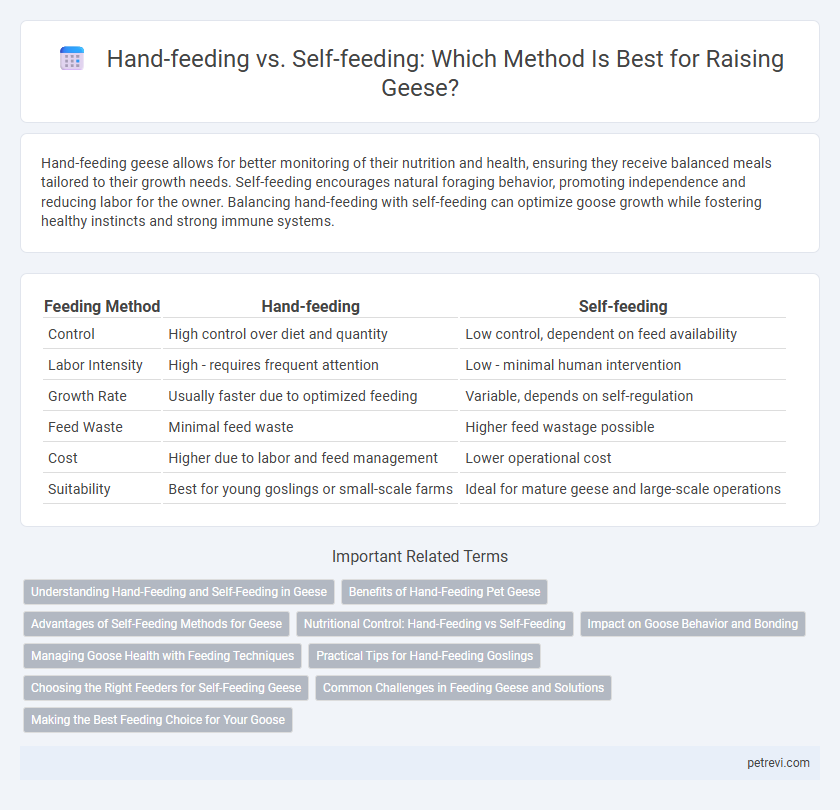Hand-feeding geese allows for better monitoring of their nutrition and health, ensuring they receive balanced meals tailored to their growth needs. Self-feeding encourages natural foraging behavior, promoting independence and reducing labor for the owner. Balancing hand-feeding with self-feeding can optimize goose growth while fostering healthy instincts and strong immune systems.
Table of Comparison
| Feeding Method | Hand-feeding | Self-feeding |
|---|---|---|
| Control | High control over diet and quantity | Low control, dependent on feed availability |
| Labor Intensity | High - requires frequent attention | Low - minimal human intervention |
| Growth Rate | Usually faster due to optimized feeding | Variable, depends on self-regulation |
| Feed Waste | Minimal feed waste | Higher feed wastage possible |
| Cost | Higher due to labor and feed management | Lower operational cost |
| Suitability | Best for young goslings or small-scale farms | Ideal for mature geese and large-scale operations |
Understanding Hand-Feeding and Self-Feeding in Geese
Hand-feeding goslings ensures precise control over nutrition and early growth, promoting stronger immunity and better weight gain during critical development stages. Self-feeding encourages natural foraging behavior and independence, reducing labor while supporting long-term health through diverse dietary intake. Optimal goose raising balances hand-feeding during the initial days with gradual transition to self-feeding to maximize health and productivity.
Benefits of Hand-Feeding Pet Geese
Hand-feeding pet geese promotes stronger human-animal bonds, leading to more social and docile behavior. Controlled feeding ensures proper nutrition, reducing the risk of malnutrition and promoting healthy growth. Regular interaction during hand-feeding allows early detection of health issues, improving overall care quality.
Advantages of Self-Feeding Methods for Geese
Self-feeding methods for geese promote natural foraging behavior, leading to healthier digestive systems and reduced labor for farmers. Geese raised with self-feeding techniques tend to develop stronger immunity and exhibit less stress compared to hand-fed birds. This approach also supports sustainable farming by minimizing feed waste and encouraging geese to regulate their own intake.
Nutritional Control: Hand-Feeding vs Self-Feeding
Hand-feeding geese allows precise control over their nutritional intake, ensuring balanced diets tailored to growth stages and health needs, which reduces the risk of nutrient deficiencies or obesity. Self-feeding systems, while more natural and cost-effective, often result in uneven consumption patterns, potentially leading to overfeeding or selective feeding behavior that compromises optimal nutrition. Effective nutritional management in goose raising depends on balancing the benefits of hand-feeding's dietary accuracy with the practicality and autonomy of self-feeding practices.
Impact on Goose Behavior and Bonding
Hand-feeding geese promotes stronger human-animal bonds by encouraging trust and reducing fear, which enhances tame behavior and easier handling. In contrast, self-feeding fosters independent foraging skills but may result in less interaction and weaker attachment between geese and their caretakers. Balancing both methods can optimize socialization while supporting natural behaviors essential for healthy goose development.
Managing Goose Health with Feeding Techniques
Hand-feeding geese ensures precise control over their nutrient intake and early detection of health issues, reducing risks of malnutrition and disease. Self-feeding encourages natural foraging behaviors, promoting digestive health and immune system strength through diversified diets. Balancing both techniques optimizes growth rates and minimizes stress, directly supporting overall goose health management.
Practical Tips for Hand-Feeding Goslings
Hand-feeding goslings requires a consistent schedule with small, frequent meals of moisture-rich, nutrient-dense feed to promote healthy growth. Use a shallow dish or syringe for gentle feeding, ensuring the goslings swallow properly to prevent aspiration. Maintain clean feeding equipment and a warm environment to reduce stress and support optimal development in hand-fed goslings.
Choosing the Right Feeders for Self-Feeding Geese
Selecting the right feeders for self-feeding geese significantly impacts their growth and health by reducing feed wastage and preventing contamination. Durable, easy-to-clean feeders designed with adjustable heights accommodate geese of different sizes and promote natural foraging behaviors. Proper feeder placement encourages social feeding habits and minimizes aggressive competition among geese, ensuring optimal nutrition intake in self-feeding systems.
Common Challenges in Feeding Geese and Solutions
Hand-feeding geese often faces challenges such as uneven food intake and increased labor, leading to variations in growth rates and health issues. Self-feeding systems can cause food wastage and contamination, resulting in digestive problems and decreased feed efficiency. Implementing controlled feeding schedules and using feeders designed to minimize spillage effectively address these issues, promoting consistent nutrition and optimal growth in geese.
Making the Best Feeding Choice for Your Goose
Hand-feeding geese ensures precise nutrition control and strengthens the bond between caregiver and bird, promoting better growth and health outcomes. Self-feeding encourages natural foraging behavior, reduces labor for the caretaker, and supports the goose's instinctual dietary preferences, which can enhance long-term well-being. Evaluating the goose's age, health status, and the rearing environment guides the best feeding method to optimize growth, immunity, and behavioral development.
Hand-feeding vs Self-feeding for Goose Raising Infographic

 petrevi.com
petrevi.com